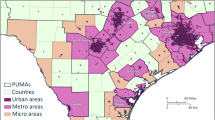Abstract.
A classic study by Harris (1954) shows a map of U.S. national accessibility. Harris argued that access to population and income represents a critical factor for location analysis. Such maps and analyses are now readily produced by geographical information systems, allowing experimentation with various parameters, and explorations of changes. By comparing changes in these measurements we can develop a synthetic picture of the impacts of population redistribution. This paper offers a comprehensive review of these calculations and illustrates their use with maps from county population in the continental U.S. from 1940 through to 2000.
Similar content being viewed by others
Author information
Authors and Affiliations
Additional information
Received: September 2002 / Accepted: January 2003
RID="*"
ID="*" Previous versions of this paper were presented to the Initiative in Population Research (IPR) workshop at the Ohio State University (Horner) and to the Center for Spatially Integrated Social Sciences (CSISS) Summer Workshop in Accessibility (O'Kelly). Thanks to the referees for helpful comments.
Rights and permissions
About this article
Cite this article
O'Kelly, M., Horner, M. Aggregate accessibility to population at the county level: U.S. 1940–2000. J Geograph Syst 5, 5–23 (2003). https://doi.org/10.1007/s101090300101
Issue Date:
DOI: https://doi.org/10.1007/s101090300101




